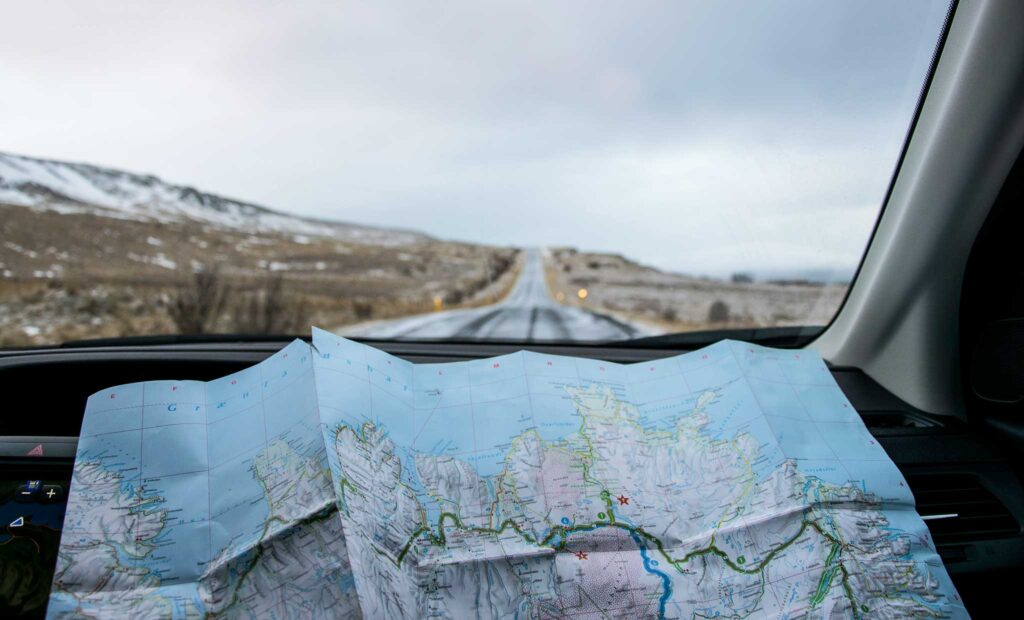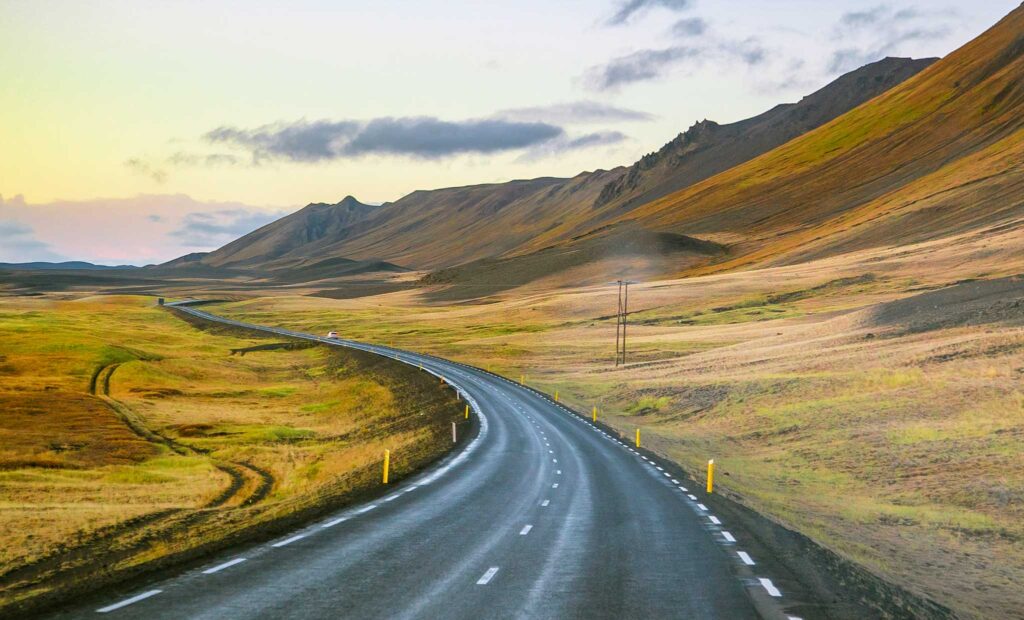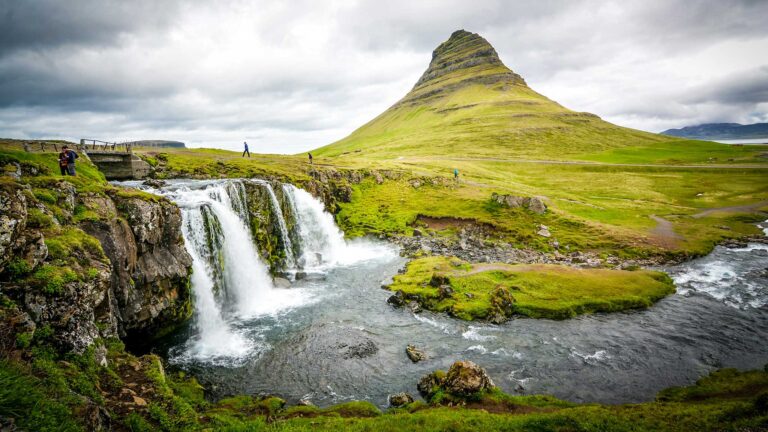Planning to hit the road in Iceland? Buckle up and get ready for one of the best driving adventures you’ll get! Whether you’re chasing waterfalls, glaciers, or the Northern Lights, driving in Iceland is an unforgettable experience – but it’s not without its quirks. Let’s cover everything you need to know about driving in Iceland, from what car to hire to how to navigate the Icelandic roads.
Why drive in Iceland?
Driving in Iceland gives you the ultimate freedom to explore all the incredible natural wonders the country has to offer, at your own pace. Want to stop and snap photos of a random herd of Icelandic horses? Go for it. Fancy a detour to one Iceland’s beautiful waterfalls? No problem. Unlike guided tours or public transport, driving yourself gives you complete flexibility – no fixed schedules or missed buses to worry about. There’s just no doubt that the best way to experience Iceland’s natural beauty is with the freedom of a car!
What Type of Car Should You Hire in Iceland?
Choosing the right car is crucial for a successful Icelandic road trip. Here’s a few of the key things to consider if you’re hiring a car:
- 2WD vs. 4WD: If you’re visiting during the summer months and sticking to Route 1 (the Ring Road), a 2WD car will do just fine. However, if you’re planning to drive on F-roads or you’re venturing into the highlands, a 4WD vehicle is essential. Just be sure to check with your car rental company that the car is suitable for F-roads.
- Winter Driving: In winter, a 4WD car with proper winter tires is a must. Snow, ice, and strong winds make winter driving challenging, and having a 4WD vehicle with good traction can make all the difference. Most car hire companies also equip their cars with studded winter tires from November to April, though you should also look for a car with traction control and anti-lock brakes if you can.
- Extras to Consider: Especially in winter, cars with a lower fuel consumption can help keep your costs low when you’re spending more time in the car with the heating on full blast (trust me, you’ll need it). And it might seem obvious (and even a bit silly), but be sure to check the car for essentials like an ice scraper before you set off!
Navigating the Roads in Iceland

The Types of Icelandic Roads
Finding your way around is fairly easy in Iceland. Here’s a quick overview of the types of Icelandic roads:
- Route 1 (The Ring Road): This is Iceland’s main highway which circles the entire island. It’s mostly paved and easy to navigate and is usually accessible even through winter.
- Gravel Roads: Common in rural areas whenever you come off the main Ring Road. Again, many are accessible even in winter though they can be a bit bumpy so drive slowly to avoid “gravel showers” on your rental car.
- F-Roads: These mountain roads in the central regions of Iceland, often referred to as the Highlands. They are only open in summer and require a 4WD vehicle. Expect river crossings and rugged terrain, but they’ll take you on one heck of an adventure!
Pro tip: While Google Maps works great in Iceland, I’d highly recommend getting a paper map as a backup, just in case you happen to lose access to data or you run out of battery on your phone.
Rules of the Road in Iceland
- Drive on the right-hand side of the road.
- Follow the speed limits: 90 km/h on paved roads and 80 km/h on gravel roads (though you’ll struggle to get up to that speed). In urban areas, speed limits are typically 50 km/h unless otherwise stated. And keep a watch out for variable speed limits during extreme weather conditions, as they may be reduced for safety. Always drive carefully, especially on gravel roads where loose stones can cause accidents if you’re driving too fast.
- Iceland has a zero tolerance for drink driving. Keep it sober.
Fuel Stations and Fuel Prices in Iceland
Fuel stations in Iceland can be few and far between, especially in remote areas. It’s wise to fill up whenever you have the chance, particularly in winter when road conditions are more extreme and your fuel consumption will be higher. That said, you’ll find N1, Orkan, and Olís stations throughout the country. Most stations are self-service and operate with credit or debit cards.
Fuel prices in Iceland are among the highest in Europe. Expect to pay a premium in rural locations too, so be sure to fill your tank before leaving Reykjavik.
Parking in Iceland
Parking in Iceland is generally straightforward:
- Parking in Urban Areas: In towns like Reykjavik, parking is often metered. Look for designated parking zones (P1, P2, etc.) and pay using meters or mobile apps like EasyPark or Parka.
- Parking at Tourist Attractions: Many popular sites now have paid parking areas to manage the number of visitors. Places like Seljalandsfoss, Skaftafell, Jökulsarlon and Kirkjufell now charge a parking fee of 1,000 ISK and while many of them can be paid online (with the EasyPark or Parka apps), keep coins or a card handy for parking meters as not all areas accept mobile payment.
Driving in Iceland in Summer

Summer driving in Iceland is a breeze (mostly). Here’s what to know:
- Road Conditions: Most roads, including F-roads, are open and well maintained. Paved roads are generally in great shape, but gravel roads can be a little rougher.
- Roads are busier: Expect roads to be at their busiest. Be considerate when it comes to stopping/parking at the side of the road and be patient with other drivers. If you encounter any single-lane bridges, slow down and let oncoming traffic cross first if you can.
- Watch for Wildlife: Watch out for sheep that might wander onto the road. They have zero respect for traffic laws.
Warning: driving off-road is strictly prohibited in Iceland and is subject to hefty fines. Staying on the roads helps reduce the impact to the Icelandic landscapes you’re there to marvel at.
Driving in Iceland in Winter

Winter driving in Iceland is no joke! Even experienced drivers who are used to driving in icy and snowy conditions will find it difficult. But with the right preparation, it’s totally doable:
- Road Conditions: While Iceland’s roads are well maintained, even in the heights of winter, it goes without saying that the roads will be very icy. Studded winter tires are a must, and even then, go slow.
- Weather Check: The weather in Iceland changes faster than you can say “Eyjafjallajökull.” Especially in winter, be prepared to face low visibility, rain, snow and heavy winds. Be sure to check the Icelandic Road Administration website for the latest information on road conditions.
- Limited Daylight: You’ll only get a few hours of daylight during the winter months, so plan your trip carefully. Be sure to budget time for exploring the highlights along your route during daylight hours and expect to drive longer distances in the dark.
Pro tip: really thick fog is common. If you run into low visibility conditions, just pull over and wait until it clears if you can. It’s better than driving off the side of the road and getting stuck in deep snow!
Driving in Iceland - FAQs
Here are some of the most common questions travellers have about driving in Iceland:
Yes, as long as your license is in Roman characters or accompanied by an International Driving Permit (IDP). Most standard licenses from Europe, North America, and other countries are valid for driving in Iceland.
Not necessarily. If you stick to the Ring Road or paved routes during summer, a 2WD vehicle is fine. However, a 4WD is essential for exploring F-roads, highlands, or driving during winter.
Yes, but only with a 4WD vehicle and some experience in handling rugged terrain. Always check weather and road conditions before heading out, as these roads can be challenging and include river crossings.
No, you should only stop at designated pullouts or parking areas. Stopping on the side of the road can be dangerous, especially on narrow or busy routes.
No. Wild camping laws have changed in recent years, so you can only camp in designated areas or with the landowner’s permission. That said, there are loads of campsites available across the country if you’re looking to do some car camping.
Visit the Icelandic Road Administration website for up-to-date information on road conditions, closures, and weather alerts. Just be sure to check the site regularly as things can change very quickly in Iceland, particularly in winter.
Driving in Iceland can be pricey because of the high fuel costs, rental fees, and insurance add-ons. That said, it’s definitely worth the cost for the freedom to explore Iceland’s breathtaking landscapes at your own pace.
And that’s it, that’s everything you need to know about driving in Iceland. It can be a little daunting but I can guarantee that having your own car in Iceland is a game changer and conquering the challenging Iceland Roads is all part of the adventure!




